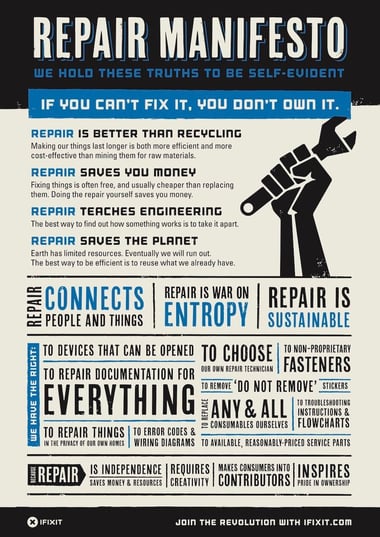The Right to Repair
"They just don't make them like they used to anymore" - you might have heard this anecdote from oldies more than a few times in reference to all sorts of manufactured goods - cars, washing machines, toasters, vacuum cleaners and phones.
The life span of devices have drastically reduced over the years. You might notice your phone start to slow down after a year or so. The batteries lasts for lesser and lesser time.
With original replacement batteries easily available, you could earlier just a pop a new battery into your Nokia device. But there are no iPhone batteries available easily at stores, repairs for an iPhone require you to go back only to Apple. These repairs are prohibitively expensive and often times impossible, with people simply not bothering to put in the effort; It's just easier to buy a new one.
This isn't something that's just happened by chance, it's due to a series of design related decisions made by these companies. Repairability and material recovery are not incorporated into the design parameters of the product. It's much more profitable for companies to sell you a new product.
There are a couple of common tactics they employ to make this happen -
Part Pairing - On the newer iPhone models replacing a broken screen display causes the fingerprint scanner and face ID to stop working. Why? These are independent components that are paired together. Replacing either one causes the functionality to break. You need to provide the phone to apple which will replace both components together.
Part pairing is an easy way to drive up the repair costs for devices.
Planned Obsolescence - One of the more infamous examples is of iPhone batteries.
Apple Inc last year was fined $113 million for artificially slowing down all older models of the iPhone. Previously in 2017, the California-based company started offering battery discounts to affected users, which could have been avoided if Apple permitted third-party battery replacements.
Apple does not allow the user to swap out the battery, nor does it sell original replacement batteries to independent repair shops. This effectively provides a monopoly to apple on battery replacements. They can choose to make it more convenient for you to buy a new phone than replace the battery...which they very much have.
Product Design - As devices have gotten smaller and more complicated, product designers have stopped factoring in the repairability into the product. Components are often glued together to prevent you from replacing them individually.
Repairing a broken key on an apple laptop requires you to replace the entire keyboard! The RAM is soldered on to the motherboard, which does not allow you to expand the computer's memory, as a desktop would.
Companies don’t want you to get their products fixed.
It took a lawsuit to force Apple to offer a battery replacement program.
Software Bricking - Brand's don't limit these decisions to just hardware design though. There are lots of software barriers to prevent people from repairing their own devices. John Deere's tractors are an example - If your JD tractor breaks down, you are required to tow it to the dealership where it is plugged into a specialised software to diagnose the problem!
What did farmers do? They hacked their tractors!
This begs the simple question - Who really owns the product? Should not the customer have the right to repair their own product?

What is the right to repair?
Once you’ve paid money for a product, the manufacturer shouldn’t be able to dictate how you use it—it’s yours. Ownership means you should be able to open, hack, repair, upgrade, or tie bells on it.
Four requirements for electronic devices are of particular importance:
- the device should be constructed and designed in a manner that allows repairs to be made easily;
- End users and independent repair providers should be able to access original spare parts and tools (software as well as physical tools) needed to repair the device at fair market conditions;
- repairs should be possible by design and not hindered by software programming;
- the repairability of a device should be clearly communicated by the manufacturer.

What can you do?
Some companies are redesigning their products with longevity in mind.
A great example is the recently launched Fairphone 4
The Fairphone comes with a 5 year warranty, and. it provides independently replaceable parts. The Puzzlephone takes it even further, with upgradable components. Phone out of space? Add som memory. Apps getting slow? Increase the speed.
While switching brands to a completely different product might be difficult for most, you can start by checking the reparability index of your product before buying it. iFixIt helps provide great manuals and starting points for getting your hands dirty on some basic repairs.
You can find out more about the Right To Repair movement in this video
Remember to Repair!



